Brighter, more broadly tunable lasers; mid-infrared detectors; and a variety of system designs have inflated the number of options available for analysis of multiple gases in low concentrations.
HANK HOGAN, CONTRIBUTING EDITOR
The hunt is on for better gas analyzers, driven by growing demands. For instance, hydrogen sulfide, an industrial byproduct, has a permissible worker exposure limit of 20 parts per million (ppm) in a confined space, according to the Occupational Safety and Health Administration (OSHA). Increasingly stringent emission regulations for greenhouse gases such as methane are also driving adoption.
Photonics-based gas analysis employs a number of techniques and component technologies, including light sources and detectors, along with an array of mirrors,
lenses, gratings, and other optical components. But all of these techniques and systems effectively take the same
approach to gathering data: They send light of a particular wavelength through a gas sample contained within a very specific path length and collect data based on how optical energy interacts with the sample. The signal data produced depends upon the intensity and path length of the light — both controllable, and therefore known, variables — and the concentration of absorbing molecules.
“The rule of thumb is, the more path length you have, the more sensitivity
you get out of your measurement,” Gary Spingarn, product manager at Hamamatsu, said.
Many gases of interest have absorption peaks in the shortwave IR (SWIR) band from 1 to 3 µm, or the in the mid-IR range between 3 and 5 µm.
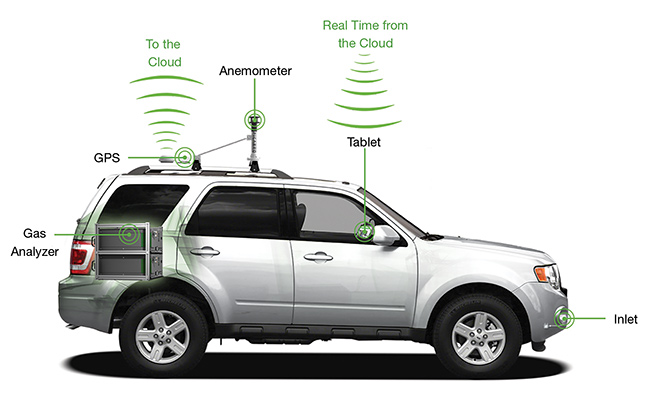
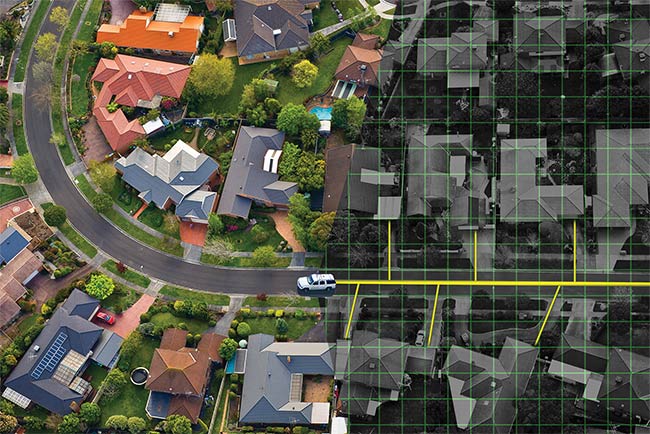
Car-mounted gas analyzers linked to GPS and cloud-based databanks (top) offer a mobile platform that can map methane plumes and help monitor the health of buried pipeline infrastructure (bottom). Courtesy of Picarro.
Absorption is often strongest in the mid-IR, Spingarn noted. The greenhouse gas CO2, for example, absorbs strongly at 4.26, 2.04, and 1.57 µm. The first wavelength is a common target for CO2 detection because the gas’s absorption at that wavelength is orders of magnitude stronger than at the other two.
Hamamatsu’s material of choice for mid-IR detectors targeting gas analysis is indium arsenide antimonide (InAsSb). In addition to providing good detection of wavelengths between 1 and 11 µm, the material also meets Restriction of Hazardous Substances (RoHS) regulations that restrict the use of lead, cadmium, and other heavy metals.
Hamamatsu further supplies LEDs and quantum cascade lasers that operate within this range. Of the two, LEDs are less expensive, but sensors that use them are only effective down to the ppm range. Quantum cascade lasers extend detection below this range by virtue of their brighter emission and narrow coherent beam, which further allows a long path length for improved sensitivity, Spingarn said.
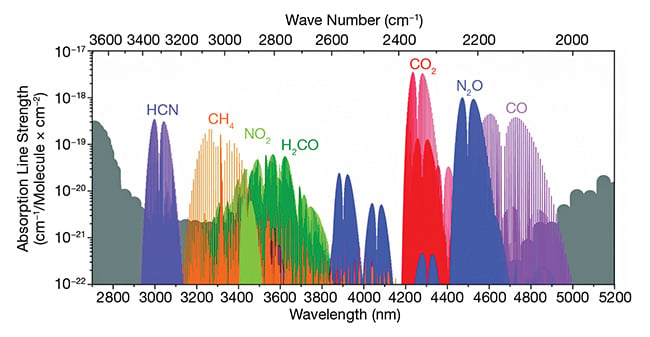
Many gases of environmental or industrial importance have absorption bands in the infrared. Courtesy of Hamamatsu.
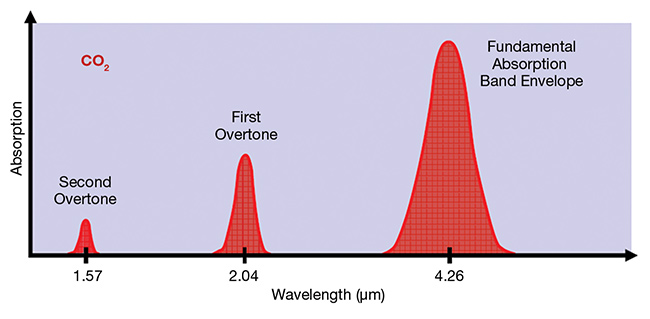
Gas absorption, and therefore its detection, is most effective when probed at the gas’s fundamental resonant wavelength. For example, CO2 absorbs the most at the fundamental, with lesser peaks at the first and second harmonic. Courtesy of Hamamatsu.
VIGO Photonics offers component solutions built on a various material technologies. With the right light source, the company’s indium gallium antimonide (InGaSb) and indium arsenide/indium arsenide antimonide (InAs/InAsSb) superlattice detector modules
enable sensing of gas concentrations down to the low tens or single parts per billion, according to Jedrzej Mijas, a technical support and sales engineer at VIGO.
“This is just a ballpark figure, let’s say for methane,” he said. “Of course, it differs from gas to gas and application to application.”
Detecting methane and monitoring other greenhouse gases is a major growth area that is driving demand for more portable, energy-efficient, and better-performing field instruments, Mijas said. In addition to miniaturizing the source and detector components, attaining these goals will require instruments with shorter optical path lengths.
One solution to this challenge would be to use higher-intensity LEDs operating in the mid-IR, which would pump more photons through a gas sample while still consuming less power than other inexpensive sources such as thermal emitters, Mijas said.
VIGO’s detector modules target gas detection and analysis applications between 2 and 16 µm. There is room for improvement in detector technology, but developing light sources with higher optical output in this range is the bigger challenge to enhanced performance,
according to Mijas.
More broadly tunable lasers could also enhance the performance of gas analysis systems, said Ruth Lindley, director of product management at Emerson. Such a development would help the company to reduce the number of lasers in its gas detection instruments while retaining the ability to sweep through the resonant wavelengths of a large number of gases.
Emerson’s Rosemount gas analyzers
include models that have as many as six mid-IR quantum cascade lasers and SWIR tunable diode lasers. Some also incorporate two different detectors to cover a broad range of wavelengths from the SWIR into the mid-IR.
Emerson’s instruments employ a patented chirp technique. “We’re pulsing the laser very fast, and it means only one laser is on at any one time,” Lindley said.
Firing the lasers sequentially and briefly cuts down on power consumption and waste heat, which helps with temperature stabilization and improves system stability and performance. Detection limits are in the sub-ppm range, which is suitable for applications such as continuous emissions monitoring for industrial plants, controlling process and product quality, and detecting leaks in products such as aerosol cans and food packages.
Better detectors
Countering the calls for better light sources, mirSense CEO Mathieu Carras
said he saw more opportunities to improve detector components when his company started to explore gas analyzer solutions. The company’s products emit light at between 3.5 and 25 µm.
While semiconductor detectors work at the lower end of this range, their signal-to-noise ratio increases with wavelength, and their performance degrades at above 10 µm. What’s more, some of these sensors have a small detection window between their noise floor and saturation. One workaround is to limit the output power of the laser to about 1 mW, but this is not an effective use of such sources.
“There are no cheap, efficient detectors in the mid-infrared,” Carras said.
Consequently, designers at mirSense opted to apply a photoacoustic method to gas analysis, keeping the laser source but entirely eliminating the photonic detector.
In this method, photons of a readily
absorbed resonant frequency pump energy into target gas molecules within a sample, which causes the molecules to emit sound waves that a microphone can pick up. Using this technique, mirSense built an industrial gas sensor that incorporates two quantum cascade lasers, a microphone, a sample chamber, and all of the supporting electronics into a 1- × 1-in. cylinder that consumes 1 W to perform an analysis, according to Carras.
The photoacoustic approach is capable of detection below a part per million, enough for many industrial settings. Carras acknowledged that the cost of a quantum cascade laser is comparatively higher than that of other light sources, but mirSense has patented approaches that could cut component cost by reducing the number of processing steps required to fabricate such lasers, he said. At high enough volumes, this approach could lower the cost of the laser to under $1 per piece — orders of magnitude lower than the current cost of quantum cascade lasers operating within this range.
Another perspective on the component improvements needed for gas analysis came from Chris Rella, a research fellow at Picarro, who did not discriminate. Every component could stand improvement, he said.
Although the mid-IR is the ideal spectral range for detecting chemical signatures, it is not the spectral region most conducive to optimal system performance, Rella said. Picarro makes cavity ring-down spectroscopy instruments capable of parts-per-billion or even parts-per-trillion concentration detection.
To accomplish such sensitivities,
Picarro’s systems combine a narrowly tunable laser for probing target wavelengths in the SWIR range with a matching detector, a wavelength monitor, and a passive optical cavity. Key to the company’s cavity ring-down spectrometers are the 99.999% reflective mirrors that form the sample cavity.
In operation, the system emits laser light into a gas that is captured in the spectrometer’s cavity and then shuts the laser off before recording how long it took for the light to become undetectable. The ring-down time corresponds directly to the concentration of a target molecule. The longer the ring time, the lower the concentration.
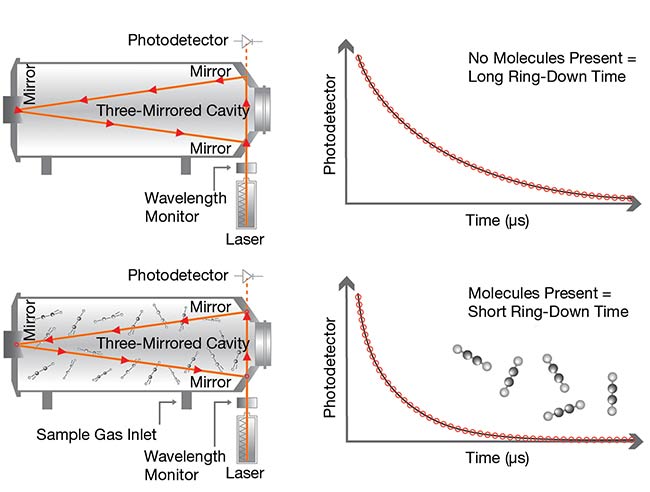
Cavity ring-down spectroscopy detects exceedingly small concentrations of gas molecules by using mirrors to significantly extend the path length of a gas analyzer’s optical cavity. Courtesy of Picarro.
The use of highly reflective mirrors allows a very small cavity to provide an immensely long path length for detection purposes. The number of round trips a pulse of light can make between the mirrors inside a footlong cavity can translate into a 20-mile path length, which enables measurement of exceedingly small gas concentrations.
“We are creating a cavity with a very high finesse,” Rella said. “There are a huge number of round trips in this cavity. It’s about 100,000.”
Mounting Picarro’s systems on a vehicle could enable the detection of very faint methane plumes, allowing utilities to determine where nearby gas-carrying infrastructure is failing and in need of repair. This could not only benefit the climate by reducing emissions of a potent greenhouse gas, it could also help to
prevent potentially explosive leaks.
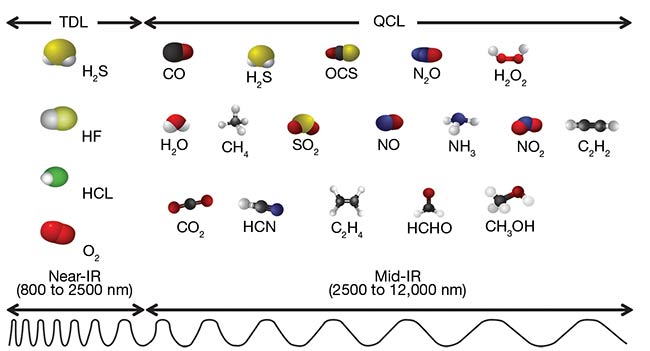
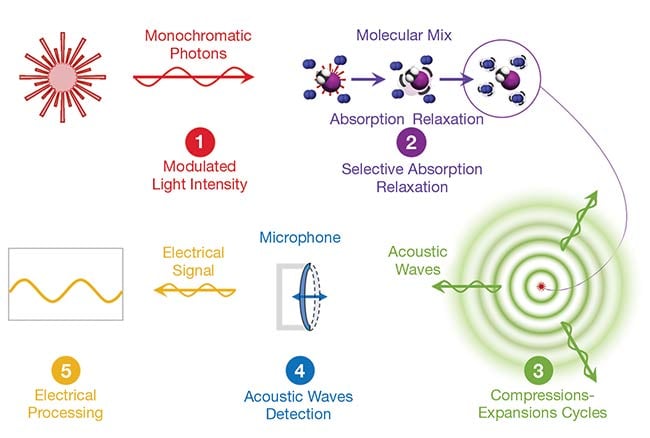
Different gas molecules exhibit peak absorption at different wavelengths (top). Though some gas analysis systems incorporate multiple lasers to probe the widest spectrum possible, adding more light sources can add expense. One alternative to help reduce costs is to employ fewer lasers that have a broadly
tunable range. TDL: tunable diode laser; QCL: quantum cascade laser. Courtesy of Emerson.
The photoacoustic effect aims laser pulses at a gas sample to deposit energy that, as the gas molecules relax, is converted into sound waves that can be picked up by a microphone and analyzed (bottom). This approach circumvents the need to find or design photodetectors that target specific wavelengths. Courtesy of mirSense.
Though Picarro’s current portfolio targets mid-IR wavelengths, the comparatively lower quality of mirrors designed for this range initially led the company to consider using mirrors designed for shorter wavelengths. Rella said there continues to be industry-wide progress in improving product performance for this spectral region, and he predicted that serviceable mid-IR lasers, detectors, fibers, and mirrors will become increasingly available.
Future detection
Whatever component improvements are in store, most gas analysis instrument-makers interviewed planned improvements to their systems.
Picarro, for example, is working to commercialize an approach incorporating a broadband IR laser that Rella said could be a game-changer for molecular detection because it would enable measurement of volatile organic compounds that are currently difficult to measure using other laser-based approaches.
Hamamatsu’s Spingarn said the company continues to develop detectors
with improved room-temperature opera-
tion and extended spectral range. He also highlighted work aimed at making quantum cascade lasers tunable and less expensive.
Making such lasers involves a batch process with many fixed costs that do not increase with production volumes. So, higher-volume applications can help cut the cost of what is often the most expensive component of a photonics-based gas analyzer.
Discussing this dynamic in making quantum cascade lasers, Spingarn said, “If you can drive the volume up, you can drive the cost down.”